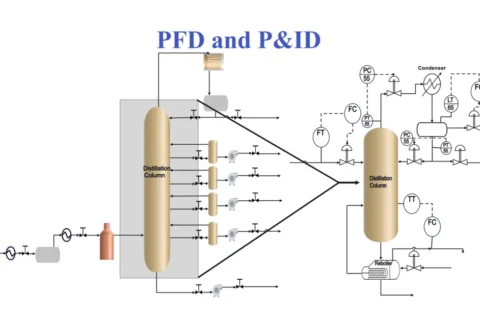Le Chatelier’s Principle, named after French chemist Henri Louis Le Chatelier, states that when a system at equilibrium is subjected to a change in conditions (such as temperature, pressure, concentration, or volume), the system will adjust its equilibrium position in a way that counteracts the change in conditions. Le Chatelier’s Principle is a useful tool for understanding and predicting the behaviour of chemical reactions and is widely used in the chemical process industry.
The Principle in Detail
When a change is introduced into a system that is otherwise in equilibrium, the system will readjust its position in the equilibrium state to account for the disruption. That is to say, if something disrupts a system’s equilibrium, it will move towards a new position that minimizes the effect of the disruption. The possible effects are :
1. Effect of change in Temperature
The chemical balance may be upset by other means as well, for as by changing the temperature. The outcome of a chemical reaction depends on whether it is endothermic or exothermic.
According to Le Chatelier’s Principle, if we increase the temperature of the system, the equilibrium will shift to account for the different circumstances. In this case, the reaction will shift to the left, meaning that more nitrogen and hydrogen will be present, and less ammonia will be formed. This is because the reaction is exothermic, and the forward reaction releases heat. By shifting the equilibrium to the left, the system will absorb the excess heat, which helps to counteract the increase in temperature.

2. Effect of Pressure
Similarly, if we lower the system’s pressure, the equilibrium will shift to accommodate the reduction. In this case, the reaction will shift to the side with more moles of gas. Since there are four moles of gas on the left side of the equation and only two on the right side, The response will go to the left, resulting in more nitrogen and hydrogen and less ammonia. This is because decreasing the pressure reduces the number of gas molecules present, and shifting the equilibrium to the left helps to increase the number of gas molecules.

3. Effect of Concentration
If we increase one of the reactant concentrations, the equilibrium will change to compensate. In this case, the reaction will shift to the right, meaning that more products will be formed. This is because increasing the concentration of one of the reactants increases the rate of the forward reaction, and shifting the equilibrium to the right helps to consume the excess reactant.

4. Effect of Change in volume
It is possible that variations in volume might impact the equilibrium of a chemical reaction involving a gas. When applied, they have an impact comparable to a shift in pressure. The equilibrium will return to its original position if the reaction is allowed to continue and the number of moles grows.
Industrial Applications of Le Chatlier’s Principle
Le Chatelier’s Principle is widely used in the chemical industry to optimize industrial processes and maximize the production of desired products. Here are some examples of its applications in various industrial processes.
Haber Process
Ammonia is produced via the Haber process, which involves the reaction of pure nitrogen and hydrogen gases at a 1:3 ratio, at a temperature of about 450 °C and a pressure of about 250 atmospheres in the presence of a molybdenum promoter and a powdered iron catalyst. By understanding le Chatelier’s principle, we can optimise these conditions to maximize ammonia production.
N2(g) + 3H2(g) ⇌ 2NH3(g)
Effect of Pressure: Gaseous moles are being consumed in the forward process (ammonia production). As a result, elevating the system’s pressure is beneficial to the synthesis of ammonia. Typically, pressures in the range of 100–250 atm are used in manufacturing.
Effect of Temperature: Ammonia dissociation is favoured because of the increased temperature caused by the exothermic forward reaction. This suggests that consistent with le Chatelier’s principle, ammonia synthesis is more favourable at lower temperatures. The response, however, will be too sluggish at lower temperatures (a kinetic restriction). Hence, in order to go past the kinetic barrier, this reaction is performed at ideal temperatures, i.e., between 450 and 550 degrees Celsius.
Removal of ammonia: Ammonia can be removed from the system periodically by liquefying it, which will also help the forward reaction.
Contact Process
In the contact method, sulphuric acid, the king of chemicals, is made on a massive scale. In order to accomplish our goal, we must take the following key actions: The transformation of sulphur dioxide (SO2) to sulphur trioxide (SO3) is a vital intermediate step. It’s a reaction that can go both ways. The equilibrium shifts to the left under typical conditions and the production of sulphur trioxide is negligible. The reaction is conducted at around 450°C and 2 atm pressure in the presence of V2O5 or Pt, which works as a catalyst, to increase the yield of sulphur trioxide.
Application of Le Chatelier’s Principle in Daily Life
Here are some examples of how Le Chatelier’s principle is applied in daily life:
- Cooking: Breadmaking uses the concept. The dough rises because yeast creates carbon dioxide when cooked. Higher temperatures accelerate the process, thus bread bakes quicker.
- Personal care products: Shampoos, conditioners, and lotions use the concept. When creating goods, producers must consider how temperature, pH, and pressure impact stability.
- Chemical production: The concept controls chemical reaction yields. Changing reaction conditions like temperature, pressure, or concentration may increase product production.
- Environmental science: Environmental science uses the idea to study how natural systems react to changes. When atmospheric carbon dioxide levels rise, the oceans absorb more carbon dioxide, changing the balance and water pH.
- Medical treatments: The concept controls medication efficacy and negative effects. When prescription pharmaceuticals, clinicians must consider blood pH, which impacts drug absorption and elimination.




